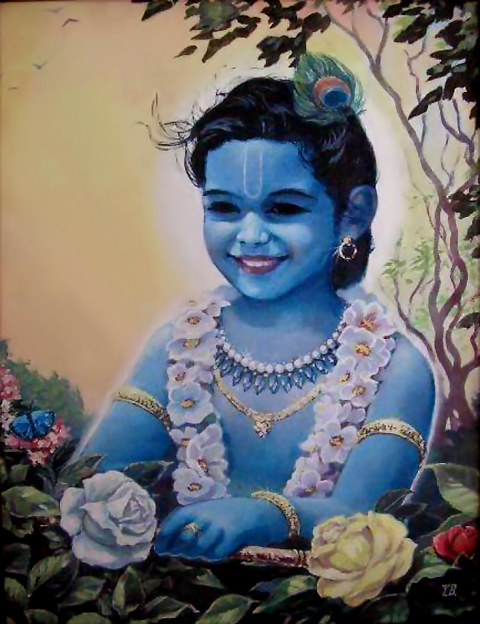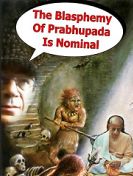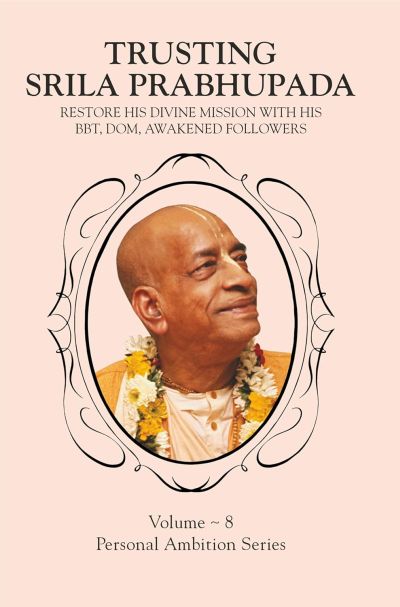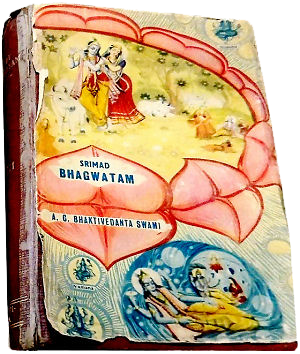
The Lord’s beauty
Śrīmad-Bhāgavatam 4.24.44-52
TEXT 44
darśanaṁ no didṛkṣūṇāṁ
dehi bhāgavatārcitam
rūpaṁ priyatamaṁ svānāṁ
sarvendriya-guṇāñjanam
My dear Lord, I wish to see You exactly in the form that Your very dear devotees worship. You have many other forms, but I wish to see Your form that is especially liked by the devotees. Please be merciful upon me and show me that form, for only that form worshiped by the devotees can perfectly satisfy all the demands of the senses.
TEXT 45-46
snigdha-prāvṛḍ-ghana-śyāmaṁ
sarva-saundarya-saṅgraham
cārv-āyata-catur-bāhu
sujāta-rucirānanam
padma-kośa-palāśākṣaṁ
sundara-bhru sunāsikam
sudvijaṁ sukapolāsyaṁ
sama-karṇa-vibhūṣaṇam
The Lord’s beauty resembles a dark cloud during the rainy season. As the rainfall glistens, His bodily features also glisten. Indeed, He is the sum total of all beauty. The Lord has four arms and an exquisitely beautiful face with eyes like lotus petals, a beautiful highly raised nose, a mind-attracting smile, a beautiful forehead and equally beautiful and fully decorated ears.
TEXTS 47–48
prīti-prahasitāpāṅgam
alakai rūpa-śobhitam
lasat-paṅkaja-kiñjalka-
dukūlaṁ mṛṣṭa-kuṇḍalam
sphurat-kirīṭa-valaya-
hāra-nūpura-mekhalam
śaṅkha-cakra-gadā-padma-
mālā-maṇy-uttamarddhimat
The Lord is superexcellently beautiful on account of His open and merciful smile and His sidelong glance upon His devotees. His black hair is curly, and His garments, waving in the wind, appear like flying saffron pollen from lotus flowers. His glittering earrings, shining helmet, bangles, garland, ankle bells, waist belt and various other bodily ornaments combine with conchshell, disc, club and lotus flower to increase the natural beauty of the Kaustubha pearl on His chest.
TEXT 49
siṁha-skandha-tviṣo bibhrat
saubhaga-grīva-kaustubham
śriyānapāyinyā kṣipta-
nikaṣāśmorasollasat
The Lord has shoulders just like a lion’s. Upon these shoulders are garlands, necklaces and epaulets, and all of these are always glittering. Besides these, there is the beauty of the Kaustubha-maṇi pearl, and on the dark chest of the Lord there are streaks named Śrīvatsa, which are signs of the goddess of fortune. The glittering of these streaks excels the beauty of the golden streaks on a gold-testing stone. Indeed, such beauty defeats a gold-testing stone.
TEXT 50
pūra-recaka-saṁvigna-
vali-valgu-dalodaram
pratisaṅkrāmayad viśvaṁ
nābhyāvarta-gabhīrayā
The Lord’s abdomen is beautiful due to three ripples in the flesh. Being so round, His abdomen resembles the leaf of a banyan tree, and when He exhales and inhales, the movement of the ripples appears very, very beautiful. The coils within the navel of the Lord are so deep that it appears that the entire universe sprouted out of it and yet again wishes to go back. (SB 4.24.50)
TEXT 51
śyāma-śroṇy-adhi-rociṣṇu-
dukūla-svarṇa-mekhalam
sama-cārv-aṅghri-jaṅghoru-
nimna-jānu-sudarśanam
The lower part of the Lord’s waist is dark and covered with yellow garments and a belt bedecked with golden embroidery work. His symmetrical lotus feet and the calves, thighs and joints of His legs are extraordinarily beautiful. Indeed, the Lord’s entire body appears to be well built.
TEXT 52
padā śarat-padma-palāśa-rociṣā
nakha-dyubhir no ’ntar-aghaṁ vidhunvatā
pradarśaya svīyam apāsta-sādhvasaṁ
padaṁ guro mārga-gurus tamo-juṣām
My dear Lord, Your two lotus feet are so beautiful that they appear like two blossoming petals of the lotus flower which grows during the autumn season. Indeed, the nails of Your lotus feet emanate such a great effulgence that they immediately dissipate all the darkness in the heart of a conditioned soul. My dear Lord, kindly show me that form of Yours which always dissipates all kinds of darkness in the heart of a devotee. My dear Lord, You are the supreme spiritual master of everyone; therefore all conditioned souls covered with the darkness of ignorance can be enlightened by You as the spiritual master.
The sweetness of Lord Kṛṣṇa
“O my Lord, the transcendental body of Kṛṣṇa is very sweet, and His face is even sweeter than His body. The soft smile on His face, which is like the fragrance of honey, is sweeter still.” (CC Madhya 21.136)
“Kṛṣṇa’s body is a city of attractive features, and it is sweeter than sweet. His face, which is like the moon, is sweeter still, and the gentle smile on that moonlike face is like rays of moonshine.” (CC Madhya 21.138)
The smile on Kṛṣṇa’s face is just like the smiling of the moon, which generates greater and greater happiness for the gopīs.
The ocean of the eternal beauty
The body of Kṛṣṇa, the ocean of the eternal beauty of youth, can be seen to move in waves of beauty. There is a whirlwind at the sound of His flute, and those waves and that whirlwind make the hearts of the gopīs flutter like dry leaves on trees, and when those leaves fall down at Kṛṣṇa’s lotus feet, they can never rise up again. There is no beauty to compare with Kṛṣṇa’s, for no one possesses beauty greater than or equal to His. Since He is the origin of all incarnations, including the form of Nārāyaṇa, the goddess of fortune, who is a constant companion of Nārāyaṇa, gives up Nārāyaṇa’s association and engages herself in penance in order to gain the association of Kṛṣṇa. Such is the greatness of the superexcellent beauty of Kṛṣṇa, the everlasting mine of all beauty. It is from that beauty that all beautiful things emanate. (Teachings of Lord Caitanya, Chapter 10)
The 24 and half moons of Kṛṣṇas beauty
The Vedic hymn known as kāma-gāyatrī describes the face of Kṛṣṇa as the king of all moons. In metaphorical language, there are many different moons, but they are all one in Kṛṣṇa. There is the moon of His mouth, the moon of His cheeks, the moonspots of sandalwood pulp on His body, the moons of the fingertips of His hands and the moons of the tips of His toes. In this way there are twenty-four and a half moons, and Kṛṣṇa is the central figure of all of them.
The dancing movement of Kṛṣṇa’s earrings, eyes and eyebrows is very attractive to the damsels of Vraja. Activities in devotional service increase the sense of devotional service. What else is there for two eyes to see beyond the face of Kṛṣṇa? Since one cannot adequately see Kṛṣṇa with only two eyes, one feels incapable and thus becomes bereaved. Such bereavement is slightly reduced when one criticizes the creative power of the creator. The unsatiated seer of Kṛṣṇa’s face nonetheless laments: “I do not have thousands of eyes, but only two, and these are disturbed by the movements of my eyelids. Therefore it is to be understood that the creator of this body is not very intelligent. He is not conversant in the art of ecstasy but is simply a prosaic creator. He does not know how to arrange things properly so one can see only Kṛṣṇa.”
The gopīs’ minds are always engaged in relishing the sweetness of Kṛṣṇa’s body. He is the ocean of beauty, and His beautiful face and smile and the luster of His body are all-attractive to the minds of the gopīs. In kṛṣṇa-karṇāmṛta, His face, smile and bodily luster have been described as sweet, sweeter and sweetest. A perfect devotee of Kṛṣṇa is overwhelmed by seeing the beauty of Kṛṣṇa’s bodily luster, His face and smile, and he bathes in the ocean of transcendental convulsions. Before Kṛṣṇa’s beauty, these convulsions often continue without treatment, just as ordinary convulsions which a physician will allow to continue, not even allowing a drink of water for relief.
The devotee increasingly feels the absence of Kṛṣṇa, for without Him one cannot drink the nectar of His beauty. When the transcendental sound of Kṛṣṇa’s flute is heard, the devotee’s anxiety to continue to hear that flute enables him to penetrate the covering of the material world and enter into the spiritual sky, where the transcendental sound of the flute enters into the ears of the followers of the gopīs. The sound of Kṛṣṇa’s flute always resides within the ears of the gopīs and increases their ecstasy. When it is heard, no other sound can enter into their ears, and amongst their family they are not able to reply to questions properly, for all these beautiful sounds are vibrating in their ears. (Teachings of Lord Caitanya, Chapter 10)
“My dear friends, Kṛṣṇa is so beautiful that the goddess of fortune always remains on His chest, and He is always adorned with a golden necklace. Beautiful Kṛṣṇa plays His flute in order to enliven the hearts of many devotees. He is the only friend of the suffering living entities. When He plays His flute, all the cows and other animals of Vṛndāvana, although engaged in eating, simply take a morsel of food in their mouths and stop chewing. Their ears raise up and they become stunned. They do not appear alive but like painted animals. Kṛṣṇa’s flute playing is so attractive that even the animals become enchanted, and what to speak of ourselves.” (Krishna Book, Chapter 34)
When Kṛṣṇa walked on the bank of the Yamunā, He was seen nicely decorated with tilaka on His head. He was garlanded with different kinds of forest flowers, and His body was smeared by the pulp of sandalwood and tulasī leaves. The bumblebees became mad after the treasure and sweet nectar of the atmosphere. Being pleased by the humming sound of the bees, Kṛṣṇa would play His flute, and together the sounds became so sweet to hear that the aquatics, the cranes, swans and ducks and other birds were charmed. Instead of swimming or flying, they became stunned. They closed their eyes and entered a trance of meditation in worship of Kṛṣṇa. (Krishna Book, Chapter 34)
The beauty of the Lord
The beauty of the Lord was so enchanting that it could not be sufficiently described. The goddess of fortune is supposed to be the most beautiful sight within the spiritual and material creations of the Lord; she has a sense of being the most beautiful, yet her beauty was defeated when the Lord appeared. In other words, the beauty of the goddess of fortune is secondary in the presence of the Lord. In the words of Vaiṣṇava poets, it is said that the Lord’s beauty is so enchanting that it defeats hundreds of thousands of Cupids. He is therefore called Madana-mohana. It is also described that the Lord sometimes becomes mad after the beauty of Rādhārāṇī. Poets describe that under those circumstances, although Lord Kṛṣṇa is Madana-mohana, He becomes Madana-dāha, or enchanted by the beauty of Rādhārāṇī. Actually the Lord’s beauty is superexcellent, surpassing even the beauty of Lakṣmī in Vaikuṇṭha. The devotees of the Lord in the Vaikuṇṭha planets want to see the Lord as the most beautiful, but the devotees in Gokula or Kṛṣṇaloka want to see Rādhārāṇī as more beautiful than Kṛṣṇa. The adjustment is that the Lord, being bhakta-vatsala, or one who wants to please His devotees, assumes such features so that devotees like Lord Brahmā, Lord Śiva and other demigods may be pleased. Here also, for the devotee-sages, the Kumāras, the Lord appeared in His most beautiful feature, and they continued to see Him without satiation and wanted to continue seeing Him more and more. (Purport SB 3.15.42)
Kṛṣṇa is so beautiful, transcendental and attractive that He sometimes attracts even Himself. The following verse appears in Gīta-govinda (1.11):
viśveṣām anurañjanena janayann ānandam indīvara-
śreṇī-śyāmala-komalair upanayann aṅgair anaṅgotsavam
svacchandaṁ vraja-sundarībhir abhitaḥ pratyaṅgam āliṅgitaḥ
śṛṅgāraḥ sakhi mūrtimān iva madhau mugdho hariḥ krīḍati
“My dear friend, just see how Kṛṣṇa is enjoying His transcendental pastimes in the spring by expanding the beauty of His personal body. His soft legs and hands, just like the most beautiful moon, are used on the bodies of the gopīs. When He embraces different parts of their bodies, He is so beautiful. Kṛṣṇa is so beautiful that He attracts even Nārāyaṇa, as well as the goddess of fortune who associates with Nārāyaṇa.”
How Kṛṣṇa is attracted by His own beauty is described in Lalita-mādhava (8.34). Upon seeing His own picture, Kṛṣṇa lamented, “How glorious this picture is! It is attracting Me just as it attracts Rādhārāṇī.” (TLC Chapter 31)
Premāñjana-cchurita-bhakti-vilocanena santaḥ sadaiva [Bs. 5.38]. Sadaiva means constantly, without any cessation, you can see God always, everywhere. Everywhere. Sthāvara jaṅgame dekhe, nā dekhe tāra mūrti. You will see tree, but you will not see the tree; you will see there Kṛṣṇa. You will see a bird, but you will see there Kṛṣṇa. That stage will come. Premāñ… When your loving spirit is developed fully like the full moon, then in the full moon night, as you can visualize the whole city, similarly, by raising yourself to the platform of loving service of Kṛṣṇa, you will see God face to face. Premāñjana-cchurita-bhakti-vilocanena santaḥ sadaiva hṛdayeṣu vilokayanti yaṁ śyāmasundaram [Bs. 5.38]. That God is Śyāmasundara. This Kṛṣṇa is called Śyāmasundara. Śyāma means blackish, but He’s very beautiful, very, very beautiful. (Srila Prabhupada Lecture, Montreal, July 4, 1968)







Speak Your Mind